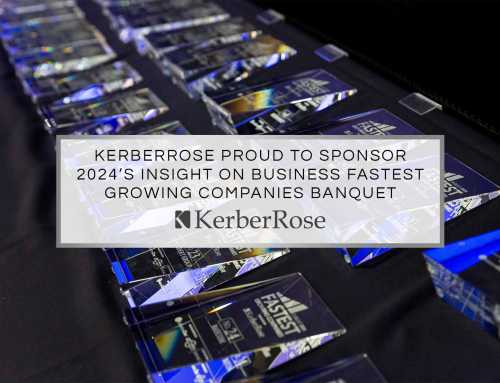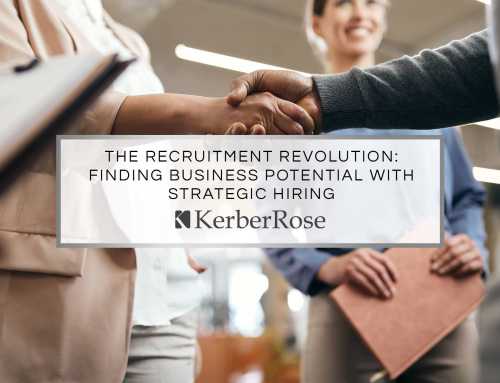Investing in Employees and Organizational Growth
An organization’s greatest asset is its people. This adage may sound cliché; however, there’s a lot of truth in it and retaining good employees is now more important than ever. An organization’s workforce encompasses a wealth of accumulated knowledge, skills, and experience. People who grow and develop with an organization are typically more productive and engaged with the organization’s strategic plan, goals, and culture; resulting in higher employee morale, lower turnover and a greater return on investment. As with most assets, an employee’s value to an organization is directly related to the energy and time invested in them. KerberRose talent development offers a way to invest in your employees by building a well-trained, highly skilled workforce to grow your organization.
The Costs of Employee Turnover
Developing and nurturing employee talent pushes your organization forward and saves money. Talent development is one of the best ways to incentivize employees to stay with an organization. If employees don’t feel challenged, don’t enjoy their work, or don’t feel there is room for growth within the organization; they are more likely to look for work elsewhere. When employees leave, they take valuable technical and organizational knowledge with them. The longer employees stay, the more skilled and competent they usually are. New hires are less likely to understand organizational nuances and processes and be productive. It can take years for a new employee to develop the same expertise.
Besides lost expertise and productivity, employee turnover is also costly for a variety of reasons:
- Recruiting new employees is time-consuming and expensive.
- Onboarding and training new employees are expensive.
- New employees who do not yet understand processes can lead to unhappy and frustrated customers, resulting in lost revenue.
- High turnover can mean employees who stay pick up the slack. This can create low morale and additional turnover costs.
In summation, employee turnover leads to a lot of unnecessary costs and barriers to organizational growth. In addition to investing money on recruiting and training costs, an organization could instead choose to invest in talent development to retain and grow its workforce from within.
Talent Development and Employee Engagement
Investing in your employees is investing in your organization and culture. By understanding and nurturing employees’ unique talents, an organization can create a more engaged workforce. A more engaged workforce reaps benefits, such as higher quality work, greater efficiency, more organizational involvement and loyalty, better employee morale, a more positive organizational culture, lower turnover, and more.
An excellent way to ensure high employee engagement is to create an environment where employees feel like they can grow and thrive. Talent development can accomplish this with professional assessments and leadership coaching. This approach helps individuals and their leaders recognize strengths and growth opportunities, effectively cultivating future leaders.
Professional Assessments and Leadership Coaching
Professional assessments provide an objective means of determining an individual’s cognitive and work skills, values, preferences, work style, and personality type. Such an assessment allows an organization to determine each employee’s skill level and unique talents, while also uncovering opportunities for improvement and growth. The organization is then in a better place to assist employees’ growth and development.
Leadership coaching is an individualized process in which feedback and professional assessments can guide employees to realize their full potential. One-on-one coaching can help individuals manage and develop their careers, develop their strengths, instill ownership for their performance and career path, and more. This individualized focus encourages employees to feel more engaged with their career path and development, while also knowing the organization for which they work is invested in their growth and success.
Using these tools is an excellent way for employees to feel their organization is invested in their individual development and advancement. When employees feel their unique talents are utilized and the work they are doing matters, they are more likely to stay with an organization. Thus, assessments and coaching are vital tools to create a positive culture and a highly engaged workforce to take your organization to the next level.
Curious about how Talent Development could be improved within your organization? Contact a KerberRose Human Resources Advisor to schedule a meeting.
Investing in Employees and Organizational Growth
An organization’s greatest asset is its people. This adage may sound cliché; however, there’s a lot of truth in it and retaining good employees is now more important than ever. An organization’s workforce encompasses a wealth of accumulated knowledge, skills, and experience. People who grow and develop with an organization are typically more productive and engaged with the organization’s strategic plan, goals, and culture; resulting in higher employee morale, lower turnover and a greater return on investment. As with most assets, an employee’s value to an organization is directly related to the energy and time invested in them. KerberRose talent development offers a way to invest in your employees by building a well-trained, highly skilled workforce to grow your organization.
The Costs of Employee Turnover
Developing and nurturing employee talent pushes your organization forward and saves money. Talent development is one of the best ways to incentivize employees to stay with an organization. If employees don’t feel challenged, don’t enjoy their work, or don’t feel there is room for growth within the organization; they are more likely to look for work elsewhere. When employees leave, they take valuable technical and organizational knowledge with them. The longer employees stay, the more skilled and competent they usually are. New hires are less likely to understand organizational nuances and processes and be productive. It can take years for a new employee to develop the same expertise.
Besides lost expertise and productivity, employee turnover is also costly for a variety of reasons:
- Recruiting new employees is time-consuming and expensive.
- Onboarding and training new employees are expensive.
- New employees who do not yet understand processes can lead to unhappy and frustrated customers, resulting in lost revenue.
- High turnover can mean employees who stay pick up the slack. This can create low morale and additional turnover costs.
In summation, employee turnover leads to a lot of unnecessary costs and barriers to organizational growth. In addition to investing money on recruiting and training costs, an organization could instead choose to invest in talent development to retain and grow its workforce from within.
Talent Development and Employee Engagement
Investing in your employees is investing in your organization and culture. By understanding and nurturing employees’ unique talents, an organization can create a more engaged workforce. A more engaged workforce reaps benefits, such as higher quality work, greater efficiency, more organizational involvement and loyalty, better employee morale, a more positive organizational culture, lower turnover, and more.
An excellent way to ensure high employee engagement is to create an environment where employees feel like they can grow and thrive. Talent development can accomplish this with professional assessments and leadership coaching. This approach helps individuals and their leaders recognize strengths and growth opportunities, effectively cultivating future leaders.
Professional Assessments and Leadership Coaching
Professional assessments provide an objective means of determining an individual’s cognitive and work skills, values, preferences, work style, and personality type. Such an assessment allows an organization to determine each employee’s skill level and unique talents, while also uncovering opportunities for improvement and growth. The organization is then in a better place to assist employees’ growth and development.
Leadership coaching is an individualized process in which feedback and professional assessments can guide employees to realize their full potential. One-on-one coaching can help individuals manage and develop their careers, develop their strengths, instill ownership for their performance and career path, and more. This individualized focus encourages employees to feel more engaged with their career path and development, while also knowing the organization for which they work is invested in their growth and success.
Using these tools is an excellent way for employees to feel their organization is invested in their individual development and advancement. When employees feel their unique talents are utilized and the work they are doing matters, they are more likely to stay with an organization. Thus, assessments and coaching are vital tools to create a positive culture and a highly engaged workforce to take your organization to the next level.
Curious about how Talent Development could be improved within your organization? Contact a KerberRose Human Resources Advisor to schedule a meeting.
Investing in Employees and Organizational Growth
An organization’s greatest asset is its people. This adage may sound cliché; however, there’s a lot of truth in it and retaining good employees is now more important than ever. An organization’s workforce encompasses a wealth of accumulated knowledge, skills, and experience. People who grow and develop with an organization are typically more productive and engaged with the organization’s strategic plan, goals, and culture; resulting in higher employee morale, lower turnover and a greater return on investment. As with most assets, an employee’s value to an organization is directly related to the energy and time invested in them. KerberRose talent development offers a way to invest in your employees by building a well-trained, highly skilled workforce to grow your organization.
The Costs of Employee Turnover
Developing and nurturing employee talent pushes your organization forward and saves money. Talent development is one of the best ways to incentivize employees to stay with an organization. If employees don’t feel challenged, don’t enjoy their work, or don’t feel there is room for growth within the organization; they are more likely to look for work elsewhere. When employees leave, they take valuable technical and organizational knowledge with them. The longer employees stay, the more skilled and competent they usually are. New hires are less likely to understand organizational nuances and processes and be productive. It can take years for a new employee to develop the same expertise.
Besides lost expertise and productivity, employee turnover is also costly for a variety of reasons:
- Recruiting new employees is time-consuming and expensive.
- Onboarding and training new employees are expensive.
- New employees who do not yet understand processes can lead to unhappy and frustrated customers, resulting in lost revenue.
- High turnover can mean employees who stay pick up the slack. This can create low morale and additional turnover costs.
In summation, employee turnover leads to a lot of unnecessary costs and barriers to organizational growth. In addition to investing money on recruiting and training costs, an organization could instead choose to invest in talent development to retain and grow its workforce from within.
Talent Development and Employee Engagement
Investing in your employees is investing in your organization and culture. By understanding and nurturing employees’ unique talents, an organization can create a more engaged workforce. A more engaged workforce reaps benefits, such as higher quality work, greater efficiency, more organizational involvement and loyalty, better employee morale, a more positive organizational culture, lower turnover, and more.
An excellent way to ensure high employee engagement is to create an environment where employees feel like they can grow and thrive. Talent development can accomplish this with professional assessments and leadership coaching. This approach helps individuals and their leaders recognize strengths and growth opportunities, effectively cultivating future leaders.
Professional Assessments and Leadership Coaching
Professional assessments provide an objective means of determining an individual’s cognitive and work skills, values, preferences, work style, and personality type. Such an assessment allows an organization to determine each employee’s skill level and unique talents, while also uncovering opportunities for improvement and growth. The organization is then in a better place to assist employees’ growth and development.
Leadership coaching is an individualized process in which feedback and professional assessments can guide employees to realize their full potential. One-on-one coaching can help individuals manage and develop their careers, develop their strengths, instill ownership for their performance and career path, and more. This individualized focus encourages employees to feel more engaged with their career path and development, while also knowing the organization for which they work is invested in their growth and success.
Using these tools is an excellent way for employees to feel their organization is invested in their individual development and advancement. When employees feel their unique talents are utilized and the work they are doing matters, they are more likely to stay with an organization. Thus, assessments and coaching are vital tools to create a positive culture and a highly engaged workforce to take your organization to the next level.
Curious about how Talent Development could be improved within your organization? Contact a KerberRose Human Resources Advisor to schedule a meeting.




